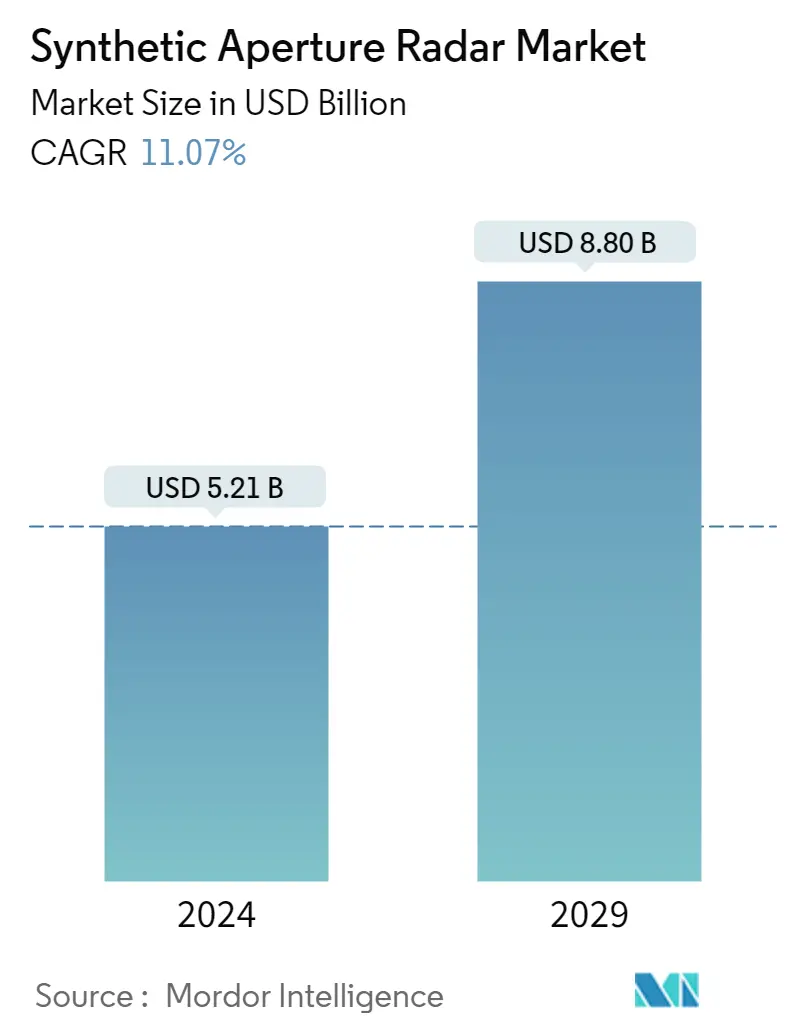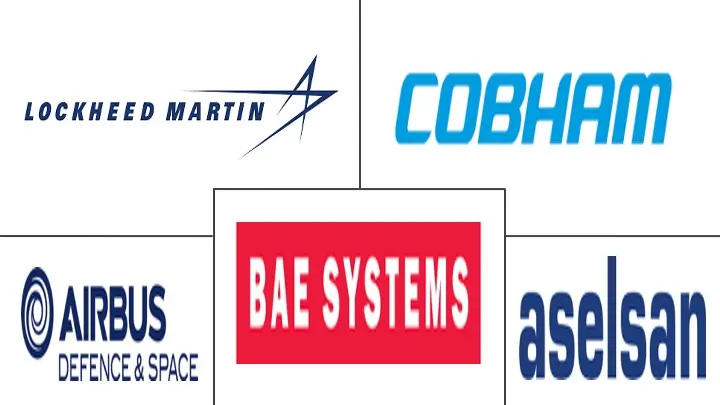Market Size of Synthetic Aperture Radar Industry

| Study Period | 2019 - 2029 |
| Market Size (2024) | USD 5.21 Billion |
| Market Size (2029) | USD 8.80 Billion |
| CAGR (2024 - 2029) | 11.07 % |
| Fastest Growing Market | Asia Pacific |
| Largest Market | North America |
Major Players
*Disclaimer: Major Players sorted in no particular order |
Synthetic Aperture Radar (SAR) Market Analysis
The Synthetic Aperture Radar Market size is estimated at USD 5.21 billion in 2024, and is expected to reach USD 8.80 billion by 2029, growing at a CAGR of 11.07% during the forecast period (2024-2029).
The pandemic has led to increased demand for satellite imagery, including the economic impact of the virus and conducting remote monitoring of facilities and infrastructure. Further, the market is witnessing increased demand from the oil and gas industry. For instance, Ursa Space Systems, which offers satellite data and analytics, observed the impact of COVID-19 on global oil inventories as the company provides weekly reports on 11,000 oil storage tanks using SAR satellites.
- With the proliferation of drones, innovation in navigation, and radar systems for Unmanned Aerial Vehicles (UAV) driving, the demand for SAR systems and data is expected to play a vital role, and vendors in the market are expected to focus on expanding their presence in this space. For instance, IMSAR produces low-weight, size, and power synthetic aperture radar systems integrated with uncrewed aerial vehicles and drones; its NSP-3 is an all-weather multi-mode SAR used for land and maritime operations.
- Moreover, the European Union's maritime safety agency (EMSA) also observed an increase in the need for SAR data, especially for its Copernicus Maritime Surveillance program, which offers earth observation products to member governments for law enforcement, fishery management, pollution monitoring, and other applications. EMSA's Copernicus Maritime Surveillance program buys Radarsat-2 data through MDA and TerraSAR-X data through Airbus; it also relies on free SAR data from Europe's Sentinel-1 satellite to detect oil spills under a separate program called CleanSeaNet.
- Over the coming years, the Asia-Pacific region is expected to increase its funding in various military and environmental missions and partner with global players to expand its SAR capabilities further. For instance, the Indian Space Research Organization (ISRO), in partnership with the National Aeronautics and Space Administration (NASA), is launching a dual-frequency synthetic aperture radar NISAR in the last year.
- Despite various advantages of the SAR systems, it is significantly underused compared to traditional optical imagery. To overcome this, the Department of Commerce and the National Oceanic and Atmospheric Administration (NOAA) announced licensing of Private Remote Sensing Space Systems, which revised the regulations for licensing the operation of private remote sensing space systems under the Land Remote Sensing Policy Act of 1992.
Synthetic Aperture Radar (SAR) Industry Segmentation
Global Synthetic aperture radar is a form of radar used to create two-dimensional images or three-dimensional reconstructions of objects, such as landscapes. SAR uses the motion of the radar antenna over a target region to provide finer spatial resolution than conventional beam-scanning radars. The study highlights critical applications across areas, such as military and defense, monitoring and exploration, and other applications.
The Global Synthetic Aperture Radar Market is segmented by Application (Military and Defense, Monitoring and Exploration) and Geography.
The market sizes and forecasts are provided in terms of value (USD million) for all the above segments.
| Application | |
| Military and Defense | |
| Monitoring and Exploration | |
| Other Applications |
| Geography | |
| North America | |
| Europe | |
| Asia Pacific | |
| Latin America | |
| Middle East and Africa |
Synthetic Aperture Radar Market Size Summary
The synthetic aperture radar (SAR) market is poised for significant growth, driven by increasing demand across various sectors such as defense, oil and gas, and environmental monitoring. The market is experiencing a surge in interest due to the heightened need for satellite imagery and remote monitoring capabilities, particularly in the wake of the pandemic. Innovations in drone technology and navigation systems are further propelling the demand for SAR systems, with companies like IMSAR leading the charge in integrating these systems with unmanned aerial vehicles. The European Union's Copernicus Maritime Surveillance program exemplifies the growing reliance on SAR data for applications ranging from law enforcement to pollution monitoring. Additionally, partnerships between organizations like the Indian Space Research Organization and NASA highlight the expanding global collaboration to enhance SAR capabilities.
In the defense sector, SAR technology is increasingly utilized for military applications, including battlefield surveillance and precision targeting. The United States, with its substantial defense budget, is at the forefront of research and development in this area, investing heavily in projects that leverage SAR for intelligence and reconnaissance missions. The market is characterized by moderate fragmentation, with numerous international and regional players striving to maintain a competitive edge through strategic collaborations and acquisitions. Notable developments include partnerships between companies like ICEYE and the European Space Agency, as well as initiatives in Canada to advance satellite imaging using SAR technology. These efforts underscore the market's dynamic nature and the ongoing commitment to harnessing SAR for a wide range of applications.
Synthetic Aperture Radar Market Size - Table of Contents
-
1. MARKET INSIGHTS
-
1.1 Market Overview
-
1.2 Industry Attractiveness - Porters Five Force Analysis
-
1.2.1 Bargaining Power of Suppliers
-
1.2.2 Bargaining Power of Buyers
-
1.2.3 Threat of New Entrants
-
1.2.4 Threat of Substitute Products
-
1.2.5 Intensity of Competitive Rivalry
-
-
1.3 Assessment of COVID-19 Impact on the Industry
-
-
2. MARKET SEGMENTATION
-
2.1 Application
-
2.1.1 Military and Defense
-
2.1.2 Monitoring and Exploration
-
2.1.3 Other Applications
-
-
2.2 Geography
-
2.2.1 North America
-
2.2.2 Europe
-
2.2.3 Asia Pacific
-
2.2.4 Latin America
-
2.2.5 Middle East and Africa
-
-
Synthetic Aperture Radar Market Size FAQs
How big is the Synthetic Aperture Radar Market?
The Synthetic Aperture Radar Market size is expected to reach USD 5.21 billion in 2024 and grow at a CAGR of 11.07% to reach USD 8.80 billion by 2029.
What is the current Synthetic Aperture Radar Market size?
In 2024, the Synthetic Aperture Radar Market size is expected to reach USD 5.21 billion.

